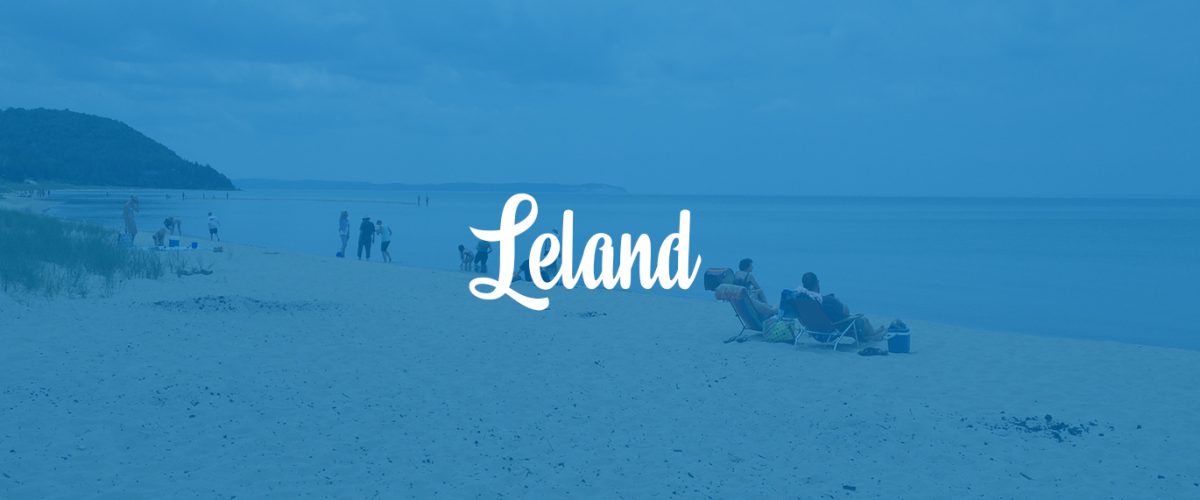
Leland: Real Estate, Landmarks, and Restaurants
Leland
Leland is a community in Michigan, located in Leland Township. It is on M-22, at the mouth of Leland River (also known as the Carp River) on Lake Michigan. Leland serves as the departure point for ferry services to both North and South Manitou Islands.
Leland River runs through the center of the community, connecting Lake Michigan and Lake Leelanau.
Nearby is The Sleeping Bear Dunes National Lakeshore. Traverse City is about 25 miles to the southeast. Leaving Leland and going south on M-22, you may spot a sign that reads “45th Parallel Halfway between Equator & North Pole”.
Leland was the county seat of Leelanau County from 1883 to 2008, when a new government center was completed in the form of Suttons Bay Township—which is closer to the county’s geographic center.Leland Homes & Real Estate
Leland Township in Leelanau County is considered one of the best places to live in Michigan. It offers a rural feel, but with lots of bars, restaurants, coffee shops, and parks for you to enjoy. With its small population, Leland is a quiet and peaceful place. It’s a nice getaway from the usual city life.
Craftsman style homes are popular here—as popular today as it was when introduced one hundred years ago, in fact. Leland architecture highlights the natural ambience of country living; and yet many properties are a stone’s throw away from North lake Leelanau and the many dining establishments in the township.
There is plenty of historical real estate that have been remodeled or renovated in recent years. Meticulously maintained and beautifully decorated, these properties give you a blast from the past while making the space more functional.
Leland Waterfront Homes for Sale
While waterfront properties are more commonly associated with places like Lake Leelanau and Torch lake, Leland has its fair share of them as well. Many of the properties listed nowadays have a private frontage on the Leland River, which gives its own stunning view. You can enjoy riverfront patios, open spaces, and a great big view of the sky.
Leland waterfront homes are designed with unobtrusive architecture, so you can fully take in the breathtaking beauty of nature. It also gives plenty of natural light.
Average Home Prices in Leland
Zillow lists the median home value in Leland as $261,320. This may be because of the smaller population in the area. But Leland home values have gone up by 2.6 percent over the past year. Zillow predicts they will fall by 1.8 percent within the next year.
The median list price per square foot in Leland is only $125. This is lower than the Myrtle Beach-Conway North Myrtle Beach Metro average of $137.
Famous Homes & Neighbors in Leland
Despite Leland’s small population, there are a couple of famous names that are associated with it.
Al Capone, the notorious gangster from Chicago who was sometimes known as Scarface, was known to visit Northern Michigan regularly. Articles show that he visited his hideout Heart’s Ease south of Leland. Legends say that many valuables are still buried somewhere near that house on Lake Michigan—and perhaps a few bodies as well. But because none of this is really confirmed by reliable sources, they are just rumors and urban legends at this moment. While the hideout was real, the “treasures” are unconfirmed—and interesting to talk about.
Another famous person who is said to live in Leland, Michigan is actor Tim Allen. People say he moved over to Leland because it was less crowded and more private. Some Leland residents reportedly spotted him in the area as well.
Tim Allen is known for playing Tim “The Toolman” Taylor on the ABC sitcom Home Improvement and Mike Baxter on the ABC/FOX sitcom Last Man Standing. He also worked on films like For Richer or Poorer (1997), Jungle 2 Jungle (1997), Galaxy Quest (1999), Big Trouble (2002), Christmas with the Kranks (2004), The Shaggy Dog (2006), Wild Hogs (2007), Redbelt (2008), and Crazy on the Outside (2010). Allen also voices Buzz Lightyear for the Toy Story franchise.
Well Known Historical Landmarks
While Leland celebrity sightings are few and mostly unconfirmed, its rich culture and history are very real. In fact, Leland has a lot of landmarks that preserve its interesting history.
Leland is built on the site of one of the oldest and largest Ottawa villages on the Leelanau Peninsula. There used to be a natural fish ladder where the Leland River flows into Lake Michigan. It was used as traditional Native American fishing grounds. The settlement was called Mishi-me-go-bing, meaning “the place where canoes run up into the river to land, because they have no harbor”. It was also known as Che-ma-go-bing or Chi-mak-a-ping.
White settlers began arriving in the 1830s and also took advantage of the location as a fishing settlement. White settlement increased after Antoine Manseau built a dam and sawmill on the river in 1854. The construction of the dam raised the water level by 12 feet. What used to be three natural lakes all became a single lake, which is now known as Lake Leelanau.
The settlers also built wooden docks, which allowed steamers and schooners to transport new settlers and supplies.
Around 1900, wealthy individuals from Chicago, Cincinnati, and Indianapolis, began to visit Leland and build summer cottages. This led to the construction of resort hotels, and the growth of Leland as a summer resort town.
There are plenty of historical landmarks to visit in Leland today. The Leelanau Historical Society and Museum, for example, showcases the cultural history of the Leelanau Peninsula and its islands. It is located at 203 E Cedar Street in Leland, on the banks of the Leland River and two blocks from Fishtown and Lake Michigan. There are exhibits that pertain to shipwrecks of the Manitou Passage, Fur Trading, Early Tourism & Recreation in the region, and many more.
Lake Leelanau Narrows Bridge is a bridge constructed in 1939 as the third bridge to cross the narrow section of Lake Leelanau. The project was part of the Federal Emergency Administration of Public Works, which is an effort to provide more jobs during the Great Depression by funding public infrastructure projects.
Leland Historic District, also known as Fishtown, contains Leland’s harbor and its surrounding area. The harbor contains docks, fishing shanties, and smokehouses established for the commercial fishing industry. Interestingly, some of these are still used for fishing today.
Another historical landmark that’s worth a visit is the Riverside Inn at 302 E. River Street. The first Riverside Inn was built in 1902 by Jacob Schwarz, who passed it to his daughters Blanche and Anna after his death. However, the inn burned in 1924, so Blanche and Anna reconstructed a nearby dancehall to make the current structure that still stands today. It is still in business, and is under owners Barb and Kate Vilter.
Restaurants in Leland
Leland’s quiet sanctuary and rich history is sure to captivate many people. But a trip to Leland is not complete without stopping by its incredible dining establishments.
The Village Cheese Shanty, located at 199 River St, Leland is a tiny business that makes the most delicious sandwiches in town. They offer a wide array of sandwiches that reviewers say are “the best”.
But if you are planning a romantic dinner for two on the riverside, The Riverside Inn Restaurant is the perfect choice. It is located at 302 River St, Leland, and it is a beautiful building that’s designed for special dinners and weekend getaways. The food is good, the setting is perfect, and the service is fantastic.
Finally, Bluebird Restaurant & Bar located at 102 River St, Leland is a great breakfast, lunch, and dinner spot with quick seating and service. It offers a simple breakfast menu, but reviewers say it’s delicious. The servers are friendly, and the pizza is highly recommended. You will want to come back here often.
In fact, why not trade the busy city life for a peaceful one at Leland, Michigan? It has a rich history, plenty of dining options, and breathtaking views of nature: it has everything you need.

